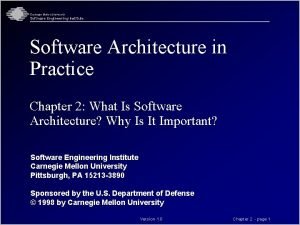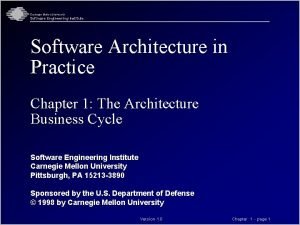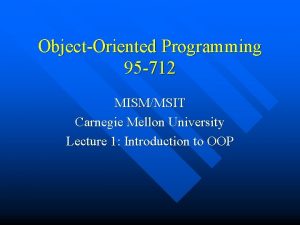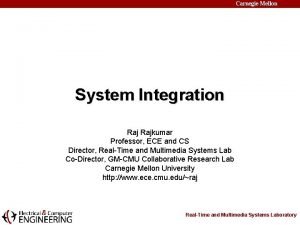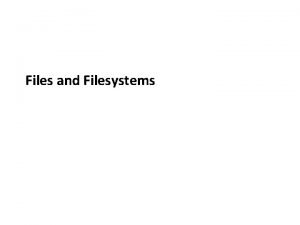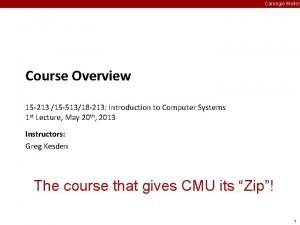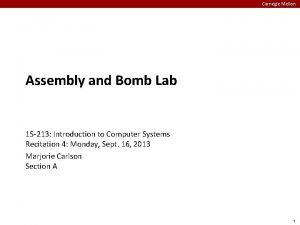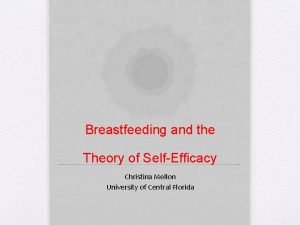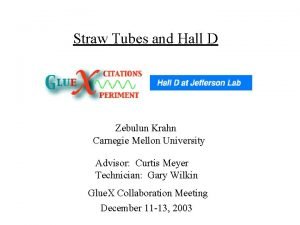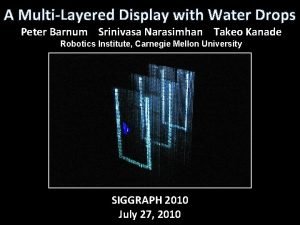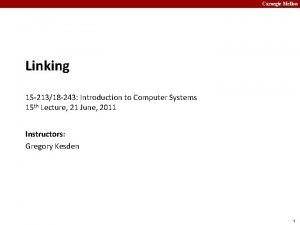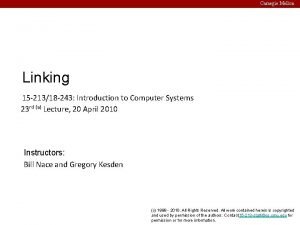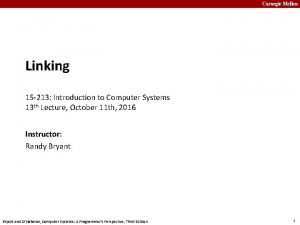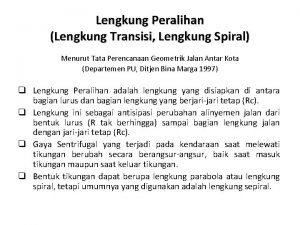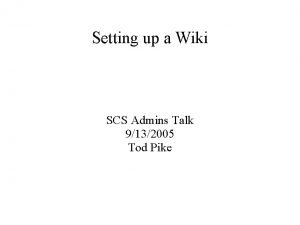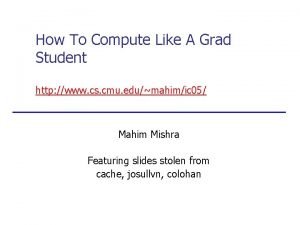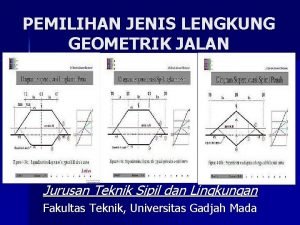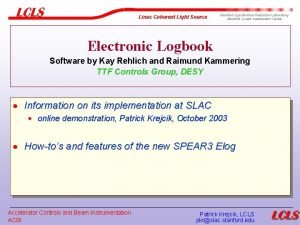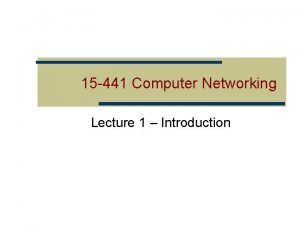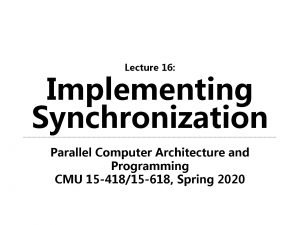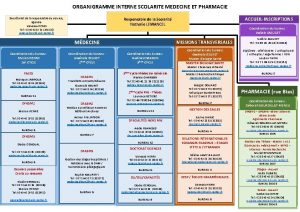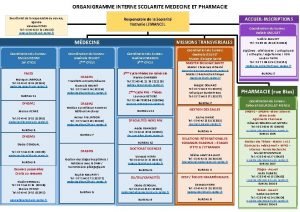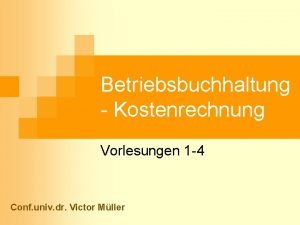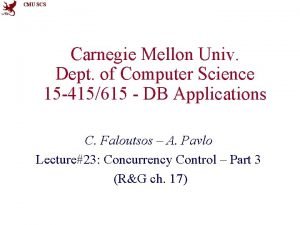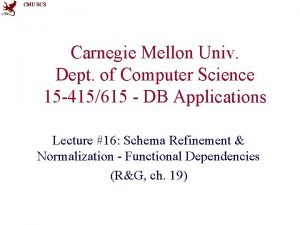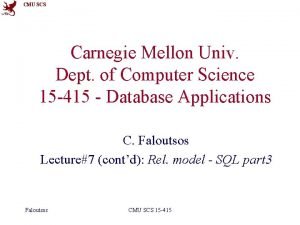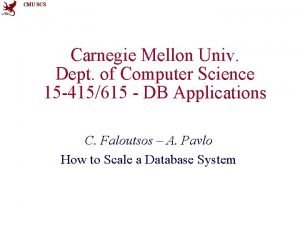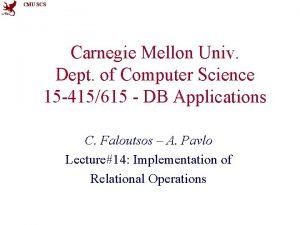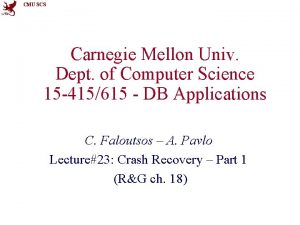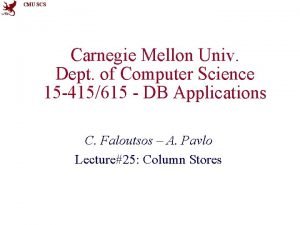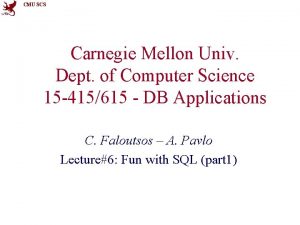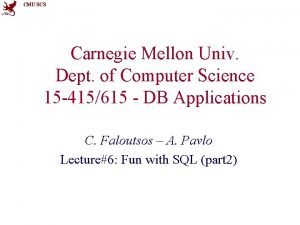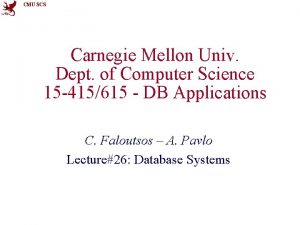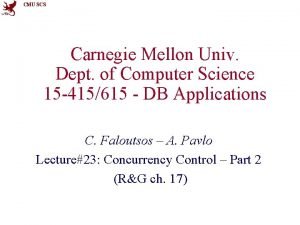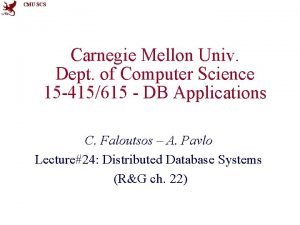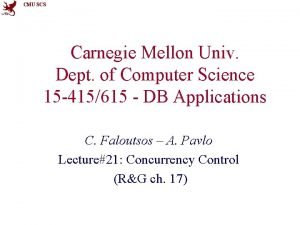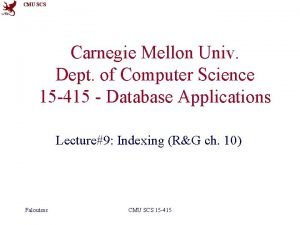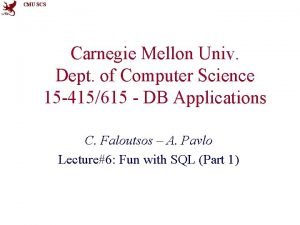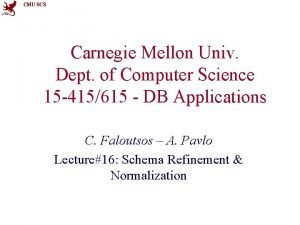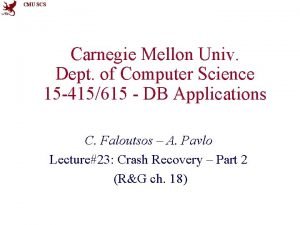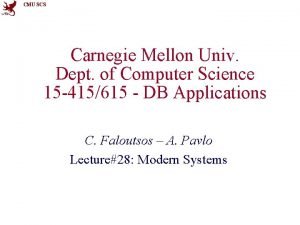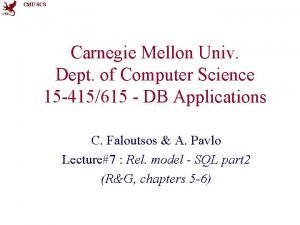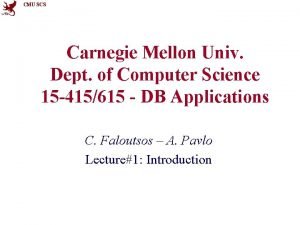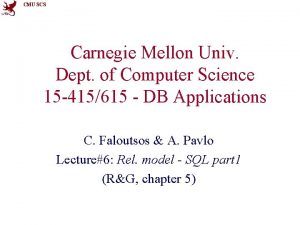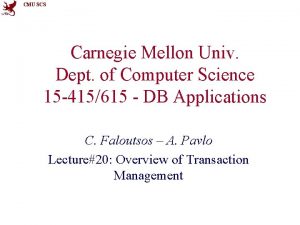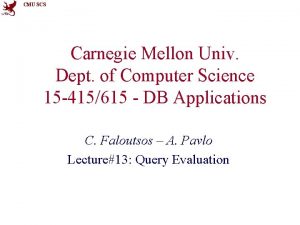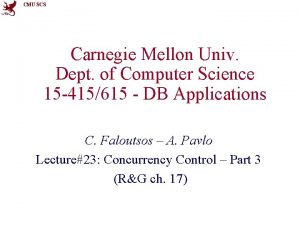CMU SCS Carnegie Mellon Univ Dept of Computer



































































































- Slides: 99

CMU SCS Carnegie Mellon Univ. Dept. of Computer Science 15 -415/615 - DB Applications C. Faloutsos – A. Pavlo Lecture#21: Concurrency Control (R&G ch. 17)

CMU SCS Last Class • • Introduction to Transactions ACID Concurrency Control Crash Recovery Faloutsos/Pavlo CMU SCS 15 -415/615 2

CMU SCS Last Class • For Isolation property, serial execution of transactions is safe but slow – We want to find schedules equivalent to serial execution but allow interleaving. • The way the DBMS does this is with its concurrency control protocol. Faloutsos/Pavlo CMU SCS 15 -415/615 3

CMU SCS Today’s Class • • • Serializability Two-Phase Locking Deadlocks Lock Granularities Locking in B+Trees Faloutsos/Pavlo CMU SCS 15 -415/615 4

CMU SCS Formal Properties of Schedules • • Serial Schedule: A schedule that does not interleave the actions of different transactions. Equivalent Schedules: For any database state, the effect of executing the first schedule is identical to the effect of executing the second schedule. * (*) no matter what the arithmetic operations are! Faloutsos/Pavlo CMU SCS 15 -415/615 5

CMU SCS Formal Properties of Schedules • Serializable Schedule: A schedule that is equivalent to some serial execution of the transactions. • Note: If each transaction preserves consistency, every serializable schedule preserves consistency. Faloutsos/Pavlo CMU SCS 15 -415/615 6

CMU SCS Example T 2 T 1 BEGIN A=A+100 B=B– 100 COMMIT BEGIN A=A*1. 06 B=B*1. 06 COMMIT • Consider two txns: – T 1 transfers $100 from B’s account to A’s – T 2 credits both accounts with 6% interest. • Assume at first A and B each have $1000. Faloutsos/Pavlo CMU SCS 15 -415/615 7

CMU SCS Example • Legal outcomes: – A=1166, B=954 →$2120 – A=1160, B=960 →$2120 • The outcome depends on whether T 1 executes before T 2 or vice versa. Faloutsos/Pavlo CMU SCS 15 -415/615 8

CMU SCS Interleaving Example (Good) Schedule T 1 T 2 TIME BEGIN A=A+100 BEGIN A=A*1. 06 B=B– 100 COMMIT B=B*1. 06 COMMIT ≡ BEGIN A=A+100 B=B– 100 COMMIT A=1166, B=954 Faloutsos/Pavlo BEGIN A=A*1. 06 B=B*1. 06 COMMIT A=1166, B=954 CMU SCS 15 -415/615 9

CMU SCS Interleaving Example (Bad) Schedule T 1 T 2 TIME BEGIN A=A+100 BEGIN A=A*1. 06 B=B*1. 06 COMMIT B=B– 100 COMMIT A=1166, B=960 Faloutsos/Pavlo ≢ A=1166, B=954 or A=1160, B=960 The bank lost $6! CMU SCS 15 -415/615 10

CMU SCS Formal Properties of Schedules • There are different levels of serializability: – Conflict Serializability – View Serializability All DBMSs support this. This is harder but allows for more concurrency. Faloutsos/Pavlo CMU SCS 15 -415/615 11

CMU SCS Conflicting Operations • We need a formal notion of equivalence that can be implemented efficiently… – Base it on the notion of “conflicting” operations • Definition: Two operations conflict if: – They are by different transactions, – They are on the same object and at least one of them is a write. Faloutsos/Pavlo CMU SCS 15 -415/615 12

CMU SCS Conflict Serializable Schedules • Two schedules are conflict equivalent iff: – They involve the same actions of the same transactions, and – Every pair of conflicting actions is ordered the same way. • Schedule S is conflict serializable if: – S is conflict equivalent to some serial schedule. Faloutsos/Pavlo CMU SCS 15 -415/615 13

CMU SCS Conflict Serializability Intuition • A schedule S is conflict serializable if: – You are able to transform S into a serial schedule by swapping consecutive nonconflicting operations of different transactions. Faloutsos/Pavlo CMU SCS 15 -415/615 14

CMU SCS Conflict Serializability Intuition TIME Schedule T 1 T 2 BEGIN R(A) W(A) R(B) W(B) COMMIT Serial Schedule T 1 T 2 BEGIN R(A) W(A) ≡ BEGIN R(A) W(A) R(B) W(B) COMMIT Faloutsos/Pavlo CMU SCS 15 -415/615 BEGIN R(A) W(A) R(B) W(B) COMMIT 15

CMU SCS Conflict Serializability Intuition Schedule T 1 T 2 TIME BEGIN R(A) W(A) COMMIT Faloutsos/Pavlo Serial Schedule T 1 T 2 COMMIT ≢ BEGIN R(A) W(A) COMMIT CMU SCS 15 -415/615 BEGIN R(A) W(A) COMMIT 16

CMU SCS Serializability • Q: Are there any faster algorithms to figure this out other than transposing operations? Faloutsos/Pavlo CMU SCS 15 -415/615 17

CMU SCS Dependency Graphs • One node per txn. • Edge from Ti to Tj if: Ti Tj – An operation Oi of Ti conflicts with an operation Oj of Tj and – Oi appears earlier in the schedule than Oj. • Also known as a “precedence graph” Faloutsos/Pavlo CMU SCS 15 -415/615 18

CMU SCS Dependency Graphs • Theorem: A schedule is conflict serializable if and only if its dependency graph is acyclic. Faloutsos/Pavlo CMU SCS 15 -415/615 19

CMU SCS Example #1 Schedule T 1 T 2 BEGIN R(A) W(A) TIME Faloutsos/Pavlo A BEGIN T 1 R(A) W(A) R(B) W(B) COMMIT Dependency Graph T 2 B The cycle in the graph reveals the problem. The output of T 1 depends on T 2, and vice-versa. CMU SCS 15 -415/615 20

CMU SCS Example #2 – Lost Update Schedule T 1 T 2 BEGIN R(A) A = A-1 Dependency Graph A BEGIN T 1 TIME R(A) A = A-1 W(A) COMMIT T 2 A W(A) COMMIT Faloutsos/Pavlo CMU SCS 15 -415/615 21

CMU SCS Example #3 – Threesome Schedule T 1 T 2 TIME BEGIN R(A) W(A) R(B) W(B) COMMIT Faloutsos/Pavlo BEGIN R(B) W(B) COMMIT Dependency Graph T 3 BEGIN R(A) W(A) COMMIT T 1 B T 2 A T 3 CMU SCS 15 -415/615 22

CMU SCS Example #3 – Threesome • Q: Is this equivalent to a serial execution? • A: Yes (T 2, T 1, T 3) – Notice that T 3 should go after T 2, although it starts before it! Faloutsos/Pavlo CMU SCS 15 -415/615 23

CMU SCS Example #4 – Inconsistent Analysis TIME Schedule T 1 T 2 BEGIN R(A) A = A-10 W(A) R(B) B = B+10 W(B) COMMIT Faloutsos/Pavlo Dependency Graph A BEGIN T 1 R(A) sum = A R(B) sum += B ECHO(sum) COMMIT T 2 B Is it possible to create a schedule similar to this that is “correct” but still not conflict serializable? CMU SCS 15 -415/615 24

CMU SCS Example #4 – Inconsistent Analysis TIME Schedule T 1 T 2 BEGIN R(A) A = A-10 W(A) R(B) B = B+10 W(B) COMMIT Faloutsos/Pavlo Dependency Graph A BEGIN T 1 R(A) if(A>0): sum = A cnt++ R(B) if(B>0): sum += B cnt++ ECHO(cnt) COMMIT T 2 B T 2 counts the number of active accounts. CMU SCS 15 -415/615 25

CMU SCS View Serializability • Alternative (weaker) notion of serializability. • Schedules S 1 and S 2 are view equivalent if: – If T 1 reads initial value of A in S 1, then T 1 also reads initial value of A in S 2. – If T 1 reads value of A written by T 2 in S 1, then T 1 also reads value of A written by T 2 in S 2. – If T 1 writes final value of A in S 1, then T 1 also writes final value of A in S 2. Faloutsos/Pavlo CMU SCS 15 -415/615 26

CMU SCS View Serializability Schedule T 1 T 2 T 3 TIME BEGIN R(A) BEGIN W(A) Dependency Graph A T 1 A BEGIN W(A) COMMIT Faloutsos/Pavlo COMMIT W(A) COMMIT CMU SCS 15 -415/615 A A T 3 T 2 A 27

CMU SCS View Serializability Schedule T 1 T 2 T 3 TIME BEGIN R(A) BEGIN W(A) COMMIT Schedule T 1 T 2 T 3 COMMIT W(A) COMMIT ≡ VIEW BEGIN R(A) W(A) COMMIT Allows all conflict serializable schedules + “blind writes” Faloutsos/Pavlo CMU SCS 15 -415/615 BEGIN W(A) COMMIT 28

CMU SCS Serializability • View Serializability allows (slightly) more schedules than Conflict Serializability does. – But is difficult to enforce efficiently. • Neither definition allows all schedules that you would consider “serializable”. – This is because they don’t understand the meanings of the operations or the data (recall example #4) Faloutsos/Pavlo CMU SCS 15 -415/615 29

CMU SCS Serializability • In practice, Conflict Serializability is what gets used, because it can be enforced efficiently. – To allow more concurrency, some special cases get handled separately, such as for travel reservations, etc. Faloutsos/Pavlo CMU SCS 15 -415/615 30

CMU SCS Schedules All Schedules View Serializable Conflict Serializable Serial Faloutsos/Pavlo 15 -415/615 31

CMU SCS Today’s Class • • • Serializability Two-Phase Locking Deadlocks Lock Granularities Locking in B+Trees Faloutsos/Pavlo CMU SCS 15 -415/615 32

CMU SCS Executing with Locks TIME T 1 T 2 BEGIN X-LOCK(A) R(A) W(A) UNLOCK(A) Granted (T 1→A) Released (T 1→A) BEGIN X-LOCK(A) W(A) UNLOCK(A) S-LOCK(A) R(A) UNLOCK(A) COMMIT Faloutsos/Pavlo Lock Manager CMU SCS 15 -415/615 Granted (T 2→A) Released (T 2→A) Granted (T 1→A) Released (T 1→A) 33

CMU SCS Two-Phase Locking • Phase 1: Growing – Each txn requests the locks that it needs from the DBMS’s lock manager. – The lock manager grants/denies lock requests. • Phase 2: Shrinking – The txn is allowed to only release locks that it previously acquired. It cannot acquire new locks. Faloutsos/Pavlo CMU SCS 15 -415/615 34

CMU SCS Two-Phase Locking • The txn is not allowed to acquire/upgrade locks after the growing phase finishes. Transaction Lifetime Growing Phase Faloutsos/Pavlo Shrinking Phase TIME CMU SCS 15 -415/615 35

CMU SCS Two-Phase Locking • The txn is not allowed to acquire/upgrade locks after the growing phase finishes. Transaction Lifetime 2 PL Violation! Growing Phase Faloutsos/Pavlo Shrinking Phase TIME CMU SCS 15 -415/615 36

CMU SCS Executing with 2 PL TIME T 1 T 2 BEGIN X-LOCK(A) R(A) W(A) Granted (T 1→A) BEGIN X-LOCK(A) R(A) UNLOCK(A) COMMIT Denied! Released (T 1→A) W(A) UNLOCK(A) COMMIT Faloutsos/Pavlo Lock Manager CMU SCS 15 -415/615 Granted (T 2→A) Released (T 2→A) 37

CMU SCS Two-Phase Locking • 2 PL on its own is sufficient to guarantee conflict serializability (i. e. , schedules whose precedence graph is acyclic), but, it is subject to cascading aborts. Growing Phase Faloutsos/Pavlo Shrinking Phase CMU SCS 15 -415/615 TIME 38

CMU SCS 2 PL – Cascading Aborts TIME Schedule T 1 T 2 BEGIN X-LOCK(A) X-LOCK(B) R(A) W(A) UNLOCK(A) X-LOCK(A) R(A) W(A) R(B) ⋮ W(B) ABORT Faloutsos/Pavlo This is a permissible schedule in 2 PL, but we have to abort T 2 too. This is all wasted work! CMU SCS 15 -415/615 39

CMU SCS 2 PL Observations • There are schedules that are serializable but would not be allowed by 2 PL. • Locking limits concurrency. • May lead to deadlocks. • May still have “dirty reads” – Solution: Strict 2 PL Faloutsos/Pavlo CMU SCS 15 -415/615 40

CMU SCS Strict Two-Phase Locking • The txn is not allowed to acquire/upgrade locks after the growing phase finishes. • Allows only conflict serializable schedules, but it is actually stronger than needed. Release all locks at end of txn. Growing Phase Faloutsos/Pavlo Shrinking Phase CMU SCS 15 -415/615 TIME 41

CMU SCS Strict Two-Phase Locking • A schedule is strict if a value written by a txn is not read or overwritten by other txns until that txn finishes. • Advantages: – Recoverable. – Do not require cascading aborts. – Aborted txns can be undone by just restoring original values of modified tuples. Faloutsos/Pavlo CMU SCS 15 -415/615 42

CMU SCS Examples • T 1: Move $50 from Andy’s account to his bookie’s account. • T 2: Compute the total amount in all accounts and return it to the application. • Legend: – A → Andy’s account. – B → The bookie’s account. Faloutsos/Pavlo CMU SCS 15 -415/615 43

CMU SCS Non-2 PL Example TIME T 1 T 2 BEGIN X-LOCK(A) R(A) S-LOCK(A) A=A-50 W(A) UNLOCK(A) R(A) UNLOCK(A) S-LOCK(B) X-LOCK(B) R(B) UNLOCK(B) R(B) ECHO(A+B) B=B+50 COMMIT W(B) UNLOCK(B) COMMIT Initial State A=100, B=100 T 2 Output 150 44

CMU SCS 2 PL Example TIME T 1 T 2 BEGIN X-LOCK(A) R(A) S-LOCK(A) A=A-50 W(A) X-LOCK(B) UNLOCK(A) R(A) S-LOCK(B) R(B) B=B+50 W(B) UNLOCK(B) COMMIT R(B) UNLOCK(A) UNLOCK(B) ECHO(A+B) COMMIT Initial State A=100, B=100 T 2 Output 200 45

CMU SCS Strict 2 PL Example TIME T 1 BEGIN X-LOCK(A) R(A) A=A-50 W(A) X-LOCK(B) R(B) B=B+50 W(B) UNLOCK(A) UNLOCK(B) COMMIT T 2 BEGIN S-LOCK(A) Initial State A=100, B=100 T 2 Output 200 R(A) S-LOCK(B) R(B) ECHO(A+B) UNLOCK(A) UNLOCK(B) COMMIT 46

CMU SCS Strict Two-Phase Locking • Txns hold all of their locks until commit. • Good: – Avoids “dirty reads” etc • Bad: – Limits concurrency even more – And still may lead to deadlocks Faloutsos/Pavlo CMU SCS 15 -415/615 47

CMU SCS Schedules All Schedules View Serializable Conflict Serializable Avoid Cascading Abort Faloutsos/Pavlo Strict 2 PL Serial 15 -415/615 48

CMU SCS Today’s Class • • • Serializability Two-Phase Locking Deadlocks Lock Granularities Locking in B+Trees Faloutsos/Pavlo CMU SCS 15 -415/615 49

CMU SCS Two-Phase Locking • 2 PL seems to work well. • Is that enough? Can we just go home now? Faloutsos/Pavlo CMU SCS 15 -415/615 50

CMU SCS Shit Just Got Real TIME T 1 Faloutsos/Pavlo T 2 BEGIN X-LOCK(A) S-LOCK(B) R(B) S-LOCK(A) R(A) X-LOCK(B) CMU SCS 15 -415/615 Lock Manager Granted (T 1→A) Granted (T 2→B) Denied! 51

CMU SCS Deadlocks • Deadlock: Cycle of transactions waiting for locks to be released by each other. • Two ways of dealing with deadlocks: – Deadlock prevention – Deadlock detection • Many systems just punt and use timeouts – What are the dangers with this approach? Faloutsos/Pavlo CMU SCS 15 -415/615 52

CMU SCS Deadlock Detection • The DBMS creates a waits-for graph: – Nodes are transactions – Edge from Ti to Tj if Ti is waiting for Tj to release a lock • The system periodically check for cycles in waits-for graph. Faloutsos/Pavlo CMU SCS 15 -415/615 53

CMU SCS Deadlock Detection TIME Schedule T 1 T 2 Waits-for Graph T 3 BEGIN S-LOCK(A) S-LOCK(D) X-LOCK(B) S-LOCK(C) S-LOCK(B) T 1 T 2 T 3 X-LOCK(C) X-LOCK(A) Faloutsos/Pavlo CMU SCS 15 -415/615 54

CMU SCS Deadlock Detection • How often should we run the algorithm? • How many txns are typically involved? • What do we do when we find a deadlock? Faloutsos/Pavlo CMU SCS 15 -415/615 55

CMU SCS Deadlock Handling • Q: What do we do? • A: Select a “victim” and rollback it back to break the deadlock. Faloutsos/Pavlo CMU SCS 15 -415/615 56

CMU SCS Deadlock Handling • Q: Which one do we choose? • A: It depends… – By age (lowest timestamp) – By progress (least/most queries executed) – By the # of items already locked – By the # of txns that we have to rollback with it • We also should consider the # of times a txn has been restarted in the past. Faloutsos/Pavlo CMU SCS 15 -415/615 57

CMU SCS Deadlock Handling • Q: How far do we rollback? • A: It depends… – Completely – Minimally (i. e. , just enough to release locks) Faloutsos/Pavlo CMU SCS 15 -415/615 58

CMU SCS Deadlock Prevention • When a txn tries to acquire a lock that is held by another txn, kill one of them to prevent a deadlock. • No waits-for graph or detection algorithm. Faloutsos/Pavlo CMU SCS 15 -415/615 59

CMU SCS Deadlock Prevention • Assign priorities based on timestamps: – Older → higher priority (e. g. , T 1 > T 2) • Two different prevention policies: – Wait-Die: If T 1 has higher priority, T 1 waits for T 2; otherwise T 1 aborts (“old wait for young”) – Wound-Wait: If T 1 has higher priority, T 2 aborts; otherwise T 1 waits (“young wait for old”) Faloutsos/Pavlo CMU SCS 15 -415/615 60

CMU SCS Deadlock Prevention T 1 T 2 BEGIN X-LOCK(A) ⋮ ⋮ T 1 Wound-Wait T 1 waits T 2 aborted Wait-Die Wound-Wait T 2 aborted T 2 waits T 2 BEGIN X-LOCK(A) ⋮ Faloutsos/Pavlo Wait-Die CMU SCS 15 -415/615 61

CMU SCS Deadlock Prevention • Q: Why do these schemes guarantee no deadlocks? • A: Only one “type” of direction allowed. • Q: When a transaction restarts, what is its (new) priority? • A: Its original timestamp. Why? Faloutsos/Pavlo CMU SCS 15 -415/615 62

CMU SCS Today’s Class • • • Serializability Two-Phase Locking Deadlocks Lock Granularities Locking in B+Trees Faloutsos/Pavlo CMU SCS 15 -415/615 63

CMU SCS Lock Granularities • When we say that a txn acquires a “lock”, what does that actually mean? – On a field? Record? Page? Table? • Ideally, each txn should obtain fewest number of locks that is needed… Faloutsos/Pavlo CMU SCS 15 -415/615 64

CMU SCS Database Lock Hierarchy Database Table 1 Tuple 1 Attr 1 Faloutsos/Pavlo Table 2 … Tuple 2 Attr 2 … CMU SCS 15 -415/615 Tuple n Attr n 65

CMU SCS Example • T 1: Get the balance of Andy’s shady offshore bank account. • T 2: Increase all account balances by 1%. • Q: What locks should they obtain? Faloutsos/Pavlo CMU SCS 15 -415/615 66

CMU SCS Example • Q: What locks should they obtain? • A: Multiple – Exclusive + Shared for leafs of lock tree. – Special Intention locks for higher levels Faloutsos/Pavlo CMU SCS 15 -415/615 67

CMU SCS Intention Locks • Intention locks allow a higher level node to be locked in S or X mode without having to check all descendent nodes. • If a node is in an intention mode, then explicit locking is being done at a lower level in the tree. Faloutsos/Pavlo CMU SCS 15 -415/615 68

CMU SCS Intention Locks • Intention-Shared (IS): Indicates explicit locking at a lower level with shared locks. • Intention-Exclusive (IX): Indicates locking at lower level with exclusive or shared locks. Faloutsos/Pavlo CMU SCS 15 -415/615 69

CMU SCS Intention Locks • Shared+Intention-Exclusive (SIX): The subtree rooted by that node is locked explicitly in shared mode and explicit locking is being done at a lower level with exclusive-mode locks. Faloutsos/Pavlo CMU SCS 15 -415/615 70

CMU SCS Compatibility Matrix T 2 Wants T 1 Holds IS IX S SIX X Faloutsos/Pavlo IS IX S SIX X ✔ ✔ X X X ✔ X X X X X CMU SCS 15 -415/615 71

CMU SCS Multiple Granularity Protocol Privileges Weaker IS IX S SIX X Stronger Faloutsos/Pavlo CMU SCS 15 -415/615 72

CMU SCS Locking Protocol • Each txn obtains appropriate lock at highest level of the database hierarchy. • To get S or IS lock on a node, the txn must hold at least IS on parent node. – What if txn holds SIX on parent? S on parent? • To get X, IX, or SIX on a node, must hold at least IX on parent node. Faloutsos/Pavlo CMU SCS 15 -415/615 73

CMU SCS Example – Two-level Hierarchy Read a single record in R. Update a single record in R. T 1 T 2 T 1 IS T 2 T 1 IX S Tuple 1 Table R T 2 X Tuple 2 … Read Faloutsos/Pavlo Tuple n Write CMU SCS 15 -415/615 74

CMU SCS Example – Threesome • Assume three txns execute at same time: – T 1: Scan R and update a few tuples. – T 2: Scan a portion of tuples in R. – T 3: Scan all tuples in R. Table R Tuple 1 Faloutsos/Pavlo Tuple 2 … CMU SCS 15 -415/615 Tuple n 75

CMU SCS Example – Threesome Scan R and update a few tuples. Scan all tuples in R. Scan a portion of tuples in R. T 1 T 2 IS S Faloutsos/Pavlo T 2 T 3 SIX T 2 T 3 S Table R T 1 X Tuple 1 Tuple 2 Read … CMU SCS 15 -415/615 Tuple n Read+Write Read 76

CMU SCS Example – Threesome • T 1: Get an SIX lock on R, then get X lock on tuples that are updated. • T 2: Get an IS lock on R, and repeatedly get an S lock on tuples of R. • T 3: Two choices: – T 3 gets an S lock on R. – OR, T 3 could behave like T 2; can use lock escalation to decide which. Faloutsos/Pavlo CMU SCS 15 -415/615 77

CMU SCS Lock Escalation • Lock escalation dynamically asks for coarser-grained locks when too many low level locks acquired. • Reduces the number of requests that the lock manager has to process. Faloutsos/Pavlo CMU SCS 15 -415/615 78

CMU SCS Multiple Lock Granularities • Useful in practice as each txn only needs a few locks. • Intention locks help improve concurrency: – Intention-Shared (IS): Intent to get S lock(s) at finer granularity. – Intention-Exclusive (IX): Intent to get X lock(s) at finer granularity. – Shared+Intention-Exclusive (SIX): Like S and IX at the same time. Faloutsos/Pavlo CMU SCS 15 -415/615 79

CMU SCS Today’s Class • • • Serializability Two-Phase Locking Deadlocks Lock Granularities Locking in B+Trees Faloutsos/Pavlo CMU SCS 15 -415/615 80

CMU SCS Locking in B+Trees • Q: What about locking indexes? • A: They are not quite like other database elements so we can treat them differently: – It’s okay to have non-serializable concurrent access to an index as long as the accuracy of the index is maintained. Faloutsos/Pavlo CMU SCS 15 -415/615 81

CMU SCS Example T 1 • • T 1 wants to insert in H T 2 wants to insert in I Q: Why not plain 2 PL? A: Because txns have to hold on to their locks for too long! T 1 CMU SCS 15 -415/615 X A X B C X T 1 G Faloutsos/Pavlo root D X E H F . . . I . . . 82

CMU SCS Lock Crabbing • Improves concurrency for B+Trees. • Get lock for parent; get lock for child; release lock for parent if “safe”. • Safe Nodes: Any node that won’t split or merge when updated. – Not full (on insertion) – More than half-full (on deletion) Faloutsos/Pavlo CMU SCS 15 -415/615 83

CMU SCS Lock Crabbing • Search: Start at root and go down; repeatedly, – S lock child – then unlock parent • Insert/Delete: Start at root and go down, obtaining X locks as needed. Once child is locked, check if it is safe: – If child is safe, release all locks on ancestors. Faloutsos/Pavlo CMU SCS 15 -415/615 84

CMU SCS Example #1 – Search 38 S A 20 S 10 It’s safe to release the lock on A. 6 B 35 12 23 S F 38 44 C S 3 4 6 9 10 11 12 13 20 22 23 31 35 36 38 41 44 G Faloutsos/Pavlo CMU SCS 15 -415/615 H I D E 85

CMU SCS Example #2 – Delete 38 X 20 A X 10 We may need to coalesce B, so we can’t release the lock on 12 23 A. 6 3 4 35 X F B 38 44 C We know that C will not X need to merge with F, so 6 9 10 11 12 13 20 22 23 31 35 36 38 41 44 it’s safe to release A+B. G H I D E Faloutsos/Pavlo CMU SCS 15 -415/615 86

CMU SCS Example #3 – Insert 45 X 20 A X 10 35 We know that if C needs to split, B has room so it’s A. 12 safe to release 23 6 X F B 38 44 C X 3 4 6 9 10 11 12 13 Faloutsos/Pavlo 20 22 23 31 35 36 38 41 44 45 room so. I it won’t GE has H D split, so we can CMU SCS 15 -415/615 release B+C. E 87

CMU SCS Example #4 – Insert 25 X A 20 X 10 B 35 X 6 12 23 31 F 38 44 C X 3 4 6 9 10 11 12 13 20 22 23 31 25 35 36 38 41 44 G H We need to split H so we need to keep the lock on 31 Faloutsos/Pavlo CMU SCS 15 -415/615 its parent node. I D E 88

CMU SCS Problems • Q: What was the first step that all of the update examples did on the B+Tree? Delete 38 X 20 Faloutsos/Pavlo Insert 45 A X 20 CMU SCS 15 -415/615 Insert 25 A X A 20 89

CMU SCS Problems • Q: What was the first step that all of the update examples did on the B+Tree? • A: Locking the root every time becomes a bottleneck with higher concurrency. • Can we do better? Faloutsos/Pavlo CMU SCS 15 -415/615 90

CMU SCS Better Tree Locking Algorithm • Main Idea: – Assume that the leaf is ‘safe’, and use S-locks & crabbing to reach it, and verify. – If leaf is not safe, then do previous algorithm. • Rudolf Bayer, Mario Schkolnick: Concurrency of Operations on B-Trees. Acta Inf. 9: 1 -21 (1977) Faloutsos/Pavlo CMU SCS 15 -415/615 91

CMU SCS Example #2 – Delete 38 S 20 A S 10 6 35 12 23 S F B 38 44 C X 3 4 6 9 10 11 12 13 Faloutsos/Pavlo 20 22 23 31 35 36 38 41 44 G H I D D will not need to CMU SCS 15 -415/615 coalesce, so we’re safe! E 92

CMU SCS Example #4 – Insert 25 S A 20 S 10 B 35 S 6 12 23 31 F 38 44 C X 3 4 6 9 10 11 12 13 20 22 23 31 25 35 36 38 41 44 G H We need to split H so we have to restart and re. Faloutsos/Pavlo CMU SCS 15 -415/615 execute like before. I D E 93

CMU SCS Better Tree Locking Algorithm • Search: Same as before. • Insert/Delete: – Set locks as if for search, get to leaf, and set X lock on leaf. – If leaf is not safe, release all locks, and restart txn using previous Insert/Delete protocol. • Gambles that only leaf node will be modified; if not, S locks set on the first pass to leaf are wasteful. Faloutsos/Pavlo CMU SCS 15 -415/615 94

CMU SCS Additional Points • Q: Which order to release locks in multiplegranularity locking? • A: From the bottom up • Q: Which order to release locks in treelocking? • A: As early as possible to maximize concurrency. Faloutsos/Pavlo CMU SCS 15 -415/615 95

CMU SCS Locking in Practice • You typically don’t set locks manually. • Sometimes you will need to provide the DBMS with hints to help it to improve concurrency. • Also useful for doing major changes. Faloutsos/Pavlo CMU SCS 15 -415/615 96

CMU SCS LOCK TABLE Postgres LOCK TABLE <table> IN <mode> MODE; My. SQL LOCK TABLE <table> <mode>; • Explicitly locks a table. • Not part of the SQL standard. – Postgres Modes: SHARE, EXCLUSIVE – My. SQL Modes: READ, WRITE Faloutsos/Pavlo CMU SCS 15 -415/615 97

CMU SCS SELECT. . . FOR UPDATE SELECT * FROM <table> WHERE <qualification> FOR UPDATE; • Perform a select and then sets an exclusive lock on the matching tuples. • Can also set shared locks: – Postgres: FOR SHARE – My. SQL: LOCK IN SHARE MODE Faloutsos/Pavlo CMU SCS 15 -415/615 98

CMU SCS Concurrency Control Summary • Conflict Serializability ↔ Correctness • Automatically correct interleavings: – Locks + protocol (2 PL, S 2 PL. . . ) – Deadlock detection + handling – Deadlock prevention Faloutsos/Pavlo CMU SCS 15 -415/615 99
 Comp bio cmu
Comp bio cmu Carnegie mellon interdisciplinary
Carnegie mellon interdisciplinary Carnegie mellon software architecture
Carnegie mellon software architecture Bomb lab solutions
Bomb lab solutions Carnegie mellon software architecture
Carnegie mellon software architecture Cmu citi training
Cmu citi training Cmu mism
Cmu mism Randy pausch carnegie mellon
Randy pausch carnegie mellon Carnegie mellon what is rpa robotic process automation
Carnegie mellon what is rpa robotic process automation Carnegie mellon
Carnegie mellon Carnegie mellon
Carnegie mellon Carnegie mellon vpn
Carnegie mellon vpn Carnegie mellon
Carnegie mellon Carnegie mellon
Carnegie mellon Carnegie mellon
Carnegie mellon Frax
Frax Carnegie mellon fat letter
Carnegie mellon fat letter Carnegie mellon
Carnegie mellon Assembly bomb lab
Assembly bomb lab Mellon serbia iskustva
Mellon serbia iskustva Carneigh mellon
Carneigh mellon Christina mellon
Christina mellon Bny mellon health savings account
Bny mellon health savings account Mellon tubes
Mellon tubes Water mellon
Water mellon Mellon elf
Mellon elf Mellon elf
Mellon elf Mellon elf
Mellon elf Travin hazelrigg
Travin hazelrigg Applied hydrology
Applied hydrology Lluvia neta
Lluvia neta Lengkung spiral
Lengkung spiral Infiltration index
Infiltration index Simbol komponen diac
Simbol komponen diac Scs curve number
Scs curve number Curva caracteristica scr
Curva caracteristica scr Color 9132005
Color 9132005 Scs.ryerson.ca harley
Scs.ryerson.ca harley Contoh rangkaian mosfet
Contoh rangkaian mosfet Scs reasonable person principle
Scs reasonable person principle Scs thyristor
Scs thyristor Scs carleton
Scs carleton Scs archiver
Scs archiver Diagram superelevasi scs
Diagram superelevasi scs Scs elogs
Scs elogs Scs lulu
Scs lulu Scs methode
Scs methode Doc scs
Doc scs Skin carotenoid score
Skin carotenoid score 15441 cmu
15441 cmu Triangulation
Triangulation Parallel computer architecture cmu
Parallel computer architecture cmu Ut arlington demographics
Ut arlington demographics Faculté de medecine constantine
Faculté de medecine constantine Http:fsi-st univ-boumerdes-dz
Http:fsi-st univ-boumerdes-dz Sug grant
Sug grant Fs.univ.umbb
Fs.univ.umbb Organigramme de pharmacie
Organigramme de pharmacie Fs.univ.umbb
Fs.univ.umbb Dysopyramide
Dysopyramide Pharmacie univ batna 2
Pharmacie univ batna 2 Scolarité médecine nantes
Scolarité médecine nantes Centre universitaire nour el bachir el bayadh
Centre universitaire nour el bachir el bayadh Prodoc univ nantes
Prodoc univ nantes Univ prof titel
Univ prof titel Moodle ustv
Moodle ustv Mail univ ouargla
Mail univ ouargla Sfa univ poitiers
Sfa univ poitiers (univ. caxias do sul) escolha a alternativa que completa
(univ. caxias do sul) escolha a alternativa que completa Lon capa ohio
Lon capa ohio Iut valenciennes ent
Iut valenciennes ent Ent univ tours
Ent univ tours Fac med univ constantine 3
Fac med univ constantine 3 Berechnung kalkulatorische zinsen
Berechnung kalkulatorische zinsen Hero br
Hero br The rise
The rise Was andrew carnegie bad
Was andrew carnegie bad Modelo de carnegie
Modelo de carnegie Dept nmr spectroscopy
Dept nmr spectroscopy Department of agriculture consumer services
Department of agriculture consumer services Finance departments
Finance departments Worcester inspectional services
Worcester inspectional services Andrew carnegie vertical integration
Andrew carnegie vertical integration Andrew carnegie vertical integration
Andrew carnegie vertical integration Dept. name of organization (of affiliation)
Dept. name of organization (of affiliation) Andrew carnegie vertical integration
Andrew carnegie vertical integration Mn dept of education
Mn dept of education Ms department of finance and administration
Ms department of finance and administration Rockefeller vertical integration
Rockefeller vertical integration Dept. name of organization (of affiliation)
Dept. name of organization (of affiliation) Carnegie and rockefeller venn diagram
Carnegie and rockefeller venn diagram Dale carnegie conversation stack
Dale carnegie conversation stack Ohio dept of dd
Ohio dept of dd Poster affiliation
Poster affiliation Carnegie learning
Carnegie learning Carnegie hall acadia
Carnegie hall acadia Vaginal dept
Vaginal dept Gome dept
Gome dept Gome dept
Gome dept Gome dept
Gome dept


